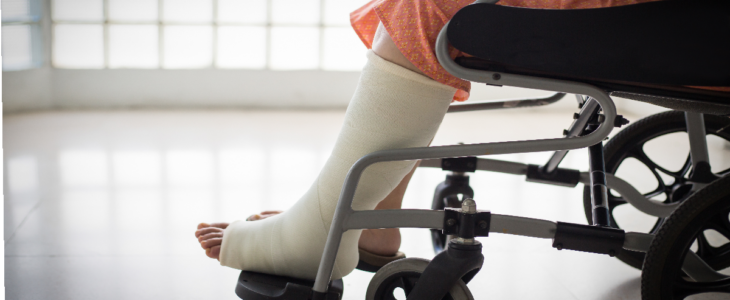The injuries you sustain in an accident can change your life. The pain you feel will likely be immediate and the effects can be widespread. Getting immediate medical attention and receiving ongoing medical care for this injury will be critical in helping to ensure you properly recover. Still, the journey ahead after sustaining a broken bone injury in an accident can be both painful and difficult.
At Pringle & Herigstad, we understand that accident injury victims will have some major hurdles thrown their way. Medical bills can pile up, work may be missed, and doctor appointments may seem endless. That is why we stand by our clients’ sides throughout the personal injury claim and recovery process. Let us take up the legal fight so that you can focus on everything else.
Common Causes of Broken Bone Injury
One of the reasons broken bone injuries are so common in accidents is that there are a number of ways in which accidents can cause them. Some of the more common causes of bone injuries in an accident include:
- Being ejected from a vehicle upon impact
- Being crushed by part of the vehicle impacted by the crash
- Bracing for impact
- Airbag deployment
- Being thrown forward into the seat restraint
- Striking hard objects, such as the dashboard, with great force
- Abnormal bending of limbs during the crash
Bones at Great Risk of Breaking in a Collision
Depending on the nature of the crash and your body’s positioning and reaction during the crash, the bone’s subject to an injury can vary greatly. The bones subjected to the greatest risk of fracture can also differ based on your vehicle type. Motorcyclists, for instance, may have increased chances of certain bone injuries as opposed to someone driving a car.
Some of the more prevalent types of broken bones resulting from motor vehicle accidents include:
- Vertebral fractures: Fractures in the vertebrae of the back or neck can be quite common. The force of impact can cause the body to be flung back or forward and this, in turn, can cause the spinal column to sustain trauma in the form of a fracture.
- Clavicle fracture: As one of the most delicate bones in the human body, it may come as no surprise that the clavicle is particularly susceptible to fracture in the event of an accident. It runs the length along the top of the rib cage and may be fractured in a severe crash. Clavicle fractures tend to be the more frequent result of a motorcycle accident.
- Pelvis fractures: Fractures of the pelvic bone also tend to be the result of a severe motor vehicle accident. They are more often seen in motorcycle accident cases.
- Leg fractures: Fractures in the lower leg, the fibula, and the upper leg, the femur, can often be the result of an accident where part of a car collapses in and crushes the leg. The force of impact is usually severe in these cases as these are strong bones and are not easily broken under normal circumstances.
Broken Bone Injury Symptoms
A broken bone will merit immediate medical attention. Be aware of the following broken bone symptoms and be sure that you immediately report to your doctor if any of them present:
- Tenderness that is sensitive to touch or movement
- Redness
- Swelling
- Bruising
- Limited mobility
- Bone exposure
- Visible deformity
- Weight-bearing limitations
Get Medical Treatment Right Away
In order to most effectively recover from a broken bone, immediate medical care can play a pivotal role. After an accident, seek medical evaluation and care right away. Any delay can increase medical complications and the risk of permanent damage. Doctors and medical personnel can assess the nature and severity of your injuries, properly diagnose things like bone breaks using the appropriate diagnostic tools, and treat the injury accordingly.
If your health and well-being are not enough motivation to seek immediate medical attention and consistent follow-up care, consider the fact that this will also be vital to the strength of your personal injury claim. Medical records will play an integral role in supporting any claim for damages you make against the at-fault party or parties to the crash. Without such evidence, your claim is likely to be denied or, at a minimum, severely undermined.
Treatment ordered for a fractured bone begins with radiographic studies, like x-rays, to determine the nature of the fracture. Broken bones will often merit the use of a splint or a cast. Healing of the bone can take at least a month. In cases of severe bone fractures, surgery may be ordered. In surgical cases, screws and plates are often implanted to help the bone properly heal and stay in place. After sustaining a broken bone, physical therapy is often ordered to help ensure full functionality of the impacted area is retained.
Contact Our North Dakota Broken Bone Injury Attorney Today
After sustaining a broken bone injury in an accident, it may feel impossible to get yourself back on track. You can trust our North Dakota team of experienced personal injury attorneys to stand by your side as your dedicated legal advocates. We want to see to it that you are properly compensated for the losses you have sustained and the harm you have suffered in an accident. Contact our office today to schedule a free consultation.
Pringle & Herigstad, P.C. is committed to supporting individuals in North Dakota, including Grand Forks, Minot, Fargo, Bismarck, Williston, Rugby, Devils Lake, Jamestown, and the surrounding areas. Our dedicated team is here to provide legal assistance and guidance to those facing the complex challenges that arise from these incidents.
